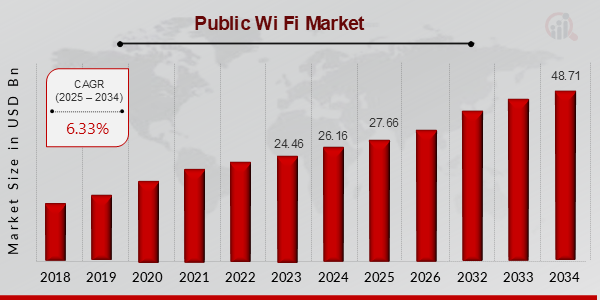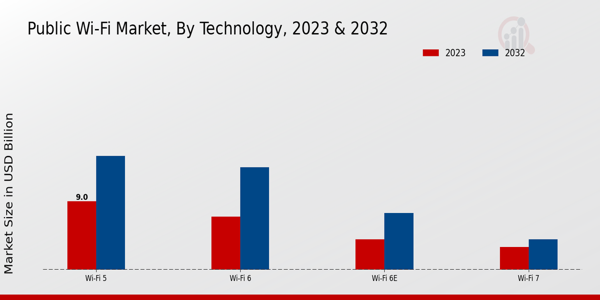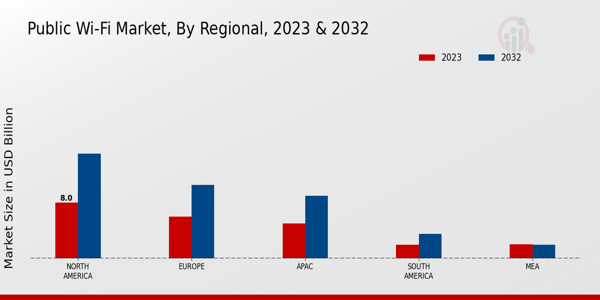Public Wi-Fi Market Overview
Public Wi Fi Market is projected to grow from USD 27.66 Billion in 2025 to USD 48.71 Billion by 2034, exhibiting a compound annual growth rate (CAGR) of 6.33% during the forecast period (2025 - 2034). Additionally, the market size for Public Wi Fi Market was valued at USD 26.16 billion in 2024.
Key Public Wi-Fi Market Trends Highlighted
The Public Wi-Fi Market is influenced by several key drivers that shape its growth and expansion. The increasing demand for connectivity in public spaces, driven by the rising use of mobile devices and the need for internet access, plays a significant role. This demand is further compounded by the growing trend of remote work and online learning, which necessitates reliable internet availability in various environments such as coffee shops, airports, and public parks. As more people depend on online services for communication and entertainment, the need for efficient public Wi-Fi solutions continues to rise. Opportunities in the Public Wi-Fi Market are expanding as many businesses, municipalities, and educational institutions recognize the potential benefits of offering free or affordable Wi-Fi services.
There is a significant opportunity for providers to develop innovative solutions that enhance user experience, such as improved speeds, security features, and easy access points. Additionally, partnerships between private companies and government entities can lead to the establishment of extensive public Wi-Fi networks that cater to a broader audience. Investing in advanced technologies, like cloud-based systems or mesh networking, can create a competitive edge for service providers in this evolving market. Recent trends indicate a shift towards increased security measures and better user management in public Wi-Fi services. Concerns about data privacy and cyber threats are prompting service providers to integrate more robust security protocols.
Moreover, the emergence of smart cities is encouraging a more extensive rollout of public Wi-Fi networks, as urban areas seek to enhance their digital infrastructure. This growing focus on interconnectedness offers a transformative experience for users, making public Wi-Fi a vital component of contemporary urban living and a critical aspect of future developments in connectivity.
Figure 1:Public Wi-Fi Market, 2025 - 2034

Source: Primary Research, Secondary Research, MRFR Database and Analyst Review
Public Wi-Fi Market Drivers
Growing Demand for Internet Connectivity
The increasing demand for Internet connectivity across urban and semi-urban areas plays a crucial role in propelling the growth of the Public Wi-Fi Market Industry. As more users seek access to the Internet for various activities, including professional work, education, entertainment, and social networking, the necessity for public Wi-Fi solutions has become more prominent. Consumers are progressively reliant on real-time data, which necessitates robust connectivity options that are not always available via traditional home broadband services.
Additionally, with the rise of smart devices and Internet of Things (IoT) applications, the pressure to enhance public Wi-Fi networks has intensified. Many businesses, municipalities, and public service providers are recognizing that offering free, accessible, and reliable Internet service is imperative to meet the expectations of tech-savvy consumers. This demand is further bolstered by the global trend of digital transformation that is observed across various sectors, including retail, education, and healthcare.
Consequently, as more public spaces such as parks, airports, and shopping malls integrate high-quality Wi-Fi solutions into their services, not only does it enhance user experience, but it also attracts more visitors, thereby creating a cycle that supports market growth and innovation.
Urbanization and Smart City Initiatives
Urbanization continues to accelerate as more people migrate to cities, creating greater demand for public infrastructure improvements, including the Public Wi-Fi Market Industry. Cities around the world are investing in smart city initiatives, which frequently include enhancements to digital connectivity to support better services for residents and visitors. The aim is to improve public safety, efficiency in transport systems, and citizen engagement, all of which rely on effective Internet access.
Increased Mobile Device Penetration
With the rapid adoption of smartphones and other mobile devices, the need for public Wi-Fi services has sharply increased, presenting a significant driver for the Public Wi-Fi Market Industry. More individuals are now accessing the Internet on the go, and as mobile device penetration continues to rise, so does the expectation for available public Wi-Fi. Enhanced connectivity options enable seamless browsing and streaming experiences for users, whether in cafes, transport hubs, or public spaces.
Public Wi-Fi Market Segment Insights
Public Wi-Fi Market Technology Insights
The Public Wi-Fi Market revenue is poised for substantial growth, driven largely by technological advancements in wireless communication. In 2023, the market was evaluated at 23.01 USD Billion, showcasing the rising demand for reliable and fast internet access in public spaces. The various technological innovations within this market segment are pivotal, particularly with Wi-Fi 5, Wi-Fi 6, Wi-Fi 6E, and Wi-Fi 7, each contributing to the market dynamics and user experience.
Wi-Fi 5, valued at 9.0 USD Billion in 2023, holds a major role in providing faster connectivity speeds and handling multiple devices simultaneously, making it a backbone for many public Wi-Fi services. As it transitions towards 2032, its valuation is projected to rise to 15.0 USD Billion, showcasing its robust market presence and ongoing relevance.
Complementing this is Wi-Fi 6, with an estimated valuation of 7.0 USD Billion in 2023 and expected to reach 13.5 USD Billion by 2032, which introduces enhanced data rates and increases the capacity for a greater number of concurrent connections. The importance of Wi-Fi 6 is accentuated by the growing trend of IoT devices, allowing for more efficient and seamless connections in crowded public spaces.
Meanwhile, the emerging Wi-Fi 6E introduces additional frequency bands, providing even broader bandwidth and reduced latency, with a current valuation of 4.0 USD Billion that is expected to grow to 7.5 USD Billion in 2032. This expanded capability is essential for supporting high-demand applications such as streaming and gaming in public environments.
Lastly, while Wi-Fi 7 is the latest entrant, its valuation at 3.01 USD Billion in 2023 is projected to increase to 4.0 USD Billion by 2032, indicating the market's recognition of its potential benefits, including speed upgrades and network efficiency. Each of these technologies plays a significant role in shaping the future landscape of public Wi-Fi, allowing various types of establishments to meet the growing consumer expectation for high-speed internet access.
Overall, the Public Wi-Fi Market segmentation highlights a clear progression in wireless technology, each segment addressing specific user needs while simultaneously contributing to the market growth, with Wi-Fi 5 and Wi-Fi 6 dominance signaling a critical phase for future advancements.
Figure 2: Public Wi-Fi Market, By Condition, 2023 & 2032

Source: Primary Research, Secondary Research, MRFR Database and Analyst Review
Public Wi-Fi Market Deployment Type Insights
In 2023, the Public Wi-Fi Market is poised for notable expansion, with a significant focus on the Deployment Type segment. This segment includes various configurations such as Managed Public Wi-Fi, Public Hotspots, and Private Network Over Public Infrastructure.
Managed Public Wi-Fi is increasingly recognized for its streamlined management and improved user experiences, driving demand across urban and enterprise environments. Public Hotspots hold a substantial share of the market, capitalizing on the growing need for accessible wireless internet in public spaces like cafes, airports, and parks, reflecting the rising trend of connectivity in everyday life.The role of Private Network Over Public Infrastructure is also gaining traction as organizations seek secure and effective solutions for their connectivity needs while leveraging existing public resources. The combination of these approaches not only enhances user convenience but also aligns with evolving consumer behaviors, making Deployment Type a critical area of interest within the Public Wi-Fi Market. The continuous evolution of this market, supported by advancements in connectivity technology and changing lifestyle patterns, contributes significantly to the overall growth trajectory and market statistics.
Public Wi-Fi Market End-Use Insights
The Public Wi-Fi Market is experiencing significant growth across various end uses, reflecting a broad demand for wireless connectivity. In 2023, the market was valued at 23.01 USD Billion, underscoring the essential role public Wi-Fi plays in facilitating connectivity in everyday settings. Key sectors such as restaurants and retail are leveraging public Wi-Fi to enhance customer experience and engagement, often seen as vital to attracting and retaining patrons. Transportation hubs have also recognized the importance of providing convenient internet access, improving customer satisfaction and operational efficiency.
Healthcare facilities utilize public Wi-Fi to ensure seamless access to patient records and telemedicine services, illustrating its critical role in modern care delivery. Educational institutions benefit from public Wi-Fi by expanding learning opportunities and fostering collaboration among students and teachers. Collectively, these end uses highlight how the Public Wi-Fi Market segmentation not only caters to diverse needs but also drives market growth by improving connectivity and service efficiency across various sectors. The extensive deployment of public Wi-Fi indicates ongoing investments and innovations aimed at enhancing user experience and satisfaction.
Public Wi-Fi Market Access Point Type Insights
The Public Wi-Fi Market in 2023 was valued at 23.01 billion USD, reflecting a growing need for connectivity solutions. The Access Point Type segment plays a crucial role in this landscape, offering various types of access points to meet diverse user demands. Among these, Indoor Access Points are essential for providing reliable connectivity in commercial spaces and public areas, enhancing user experience. Outdoor Access Points address the need for extended coverage in outdoor venues like parks and stadiums, supporting high-density user environments.
Mesh Access Points are gaining momentum as they enable seamless connectivity across wider areas without dead zones, which is especially vital for urban settings. The growth drivers for this segment include increasing smartphone penetration and the rising demand for smarter city solutions, while challenges may arise from security and infrastructure limitations. Overall, the segment contributes significantly to the overall market dynamics, indicating its importance in the evolving landscape of the Public Wi-Fi Market industry.
Public Wi-Fi Market Regional Insights
The Public Wi-Fi Market revenue is experiencing steady growth across various regions, with North America leading the way, valued at 8.0 USD Billion in 2023 and projected to reach 15.0 USD Billion by 2032, thereby demonstrating its dominance in the market.
Europe follows with a significant valuation of 6.0 USD Billion in 2023, expected to grow to 10.5 USD Billion, reflecting its importance in the Public Wi-Fi Market segmentation. The APAC region, valued at 5.0 USD Billion in 2023 and aimed for 9.0 USD Billion in 2032, is becoming increasingly pivotal due to rapid urbanization and mobile device proliferation.Meanwhile, South America stands at 2.0 USD Billion in 2023, growing to 3.5 USD Billion, showcasing a budding market that still has ample growth opportunities. Lastly, the MEA region, while less dominant with a valuation of 2.01 USD Billion in 2023, is expected to stabilize at 2.0 USD Billion by 2032, indicating potential challenges in achieving growth.
Factors like increasing internet penetration and rising demand for connectivity are fueling the market growth globally, offering various opportunities while also facing challenges related to network security and infrastructure improvements.
Figure 3: Public Wi-Fi Market, By Regional, 2023 & 2032

Source: Primary Research, Secondary Research, MRFR Database and Analyst Review
Public Wi-Fi Market Key Players and Competitive Insights
The Public Wi-Fi Market is experiencing a transformative period characterized by rapid advancements in technology, escalating demand for wireless connectivity, and a growing emphasis on enabling seamless internet access in public spaces. The increasing reliance on mobile devices drives this market, the growing trend towards smart cities, and an evolving landscape that requires secure and reliable networking solutions. Competitive insights into this market reveal a dynamic environment where established organizations and emerging players are striving to innovate and expand their offerings to capture market share. Challenges such as security concerns and regulatory requirements also play a significant role in shaping competitive strategies, fostering an atmosphere of continual improvement and adaptation within the industry.
Hewlett Packard Enterprise is a formidable presence in the Public Wi-Fi Market, leveraging its robust portfolio of networking solutions, managed services, and support offerings. The company stands out for its commitment to innovation, driven by extensive investment in research and development aimed at creating high-performance and scalable Wi-Fi solutions tailored to a wide array of public environments. Hewlett Packard Enterprise excels in deploying advanced security features in its offerings, addressing increasing concerns over data privacy and network vulnerabilities that public Wi-Fi users often encounter. Moreover, their cloud-based management solutions facilitate enhanced control and analytics, empowering organizations to optimize their Wi-Fi networks effectively. The company's strong reputation for quality and reliability further strengthens its competitive position, appealing to municipalities, transport hubs, educational institutions, and retail environments seeking to implement efficient public Wi-Fi systems.
Netgear has established a significant foothold in the Public Wi-Fi Market, recognized for delivering innovative and user-friendly networking solutions that cater to the needs of public venues. With a robust range of products, including access points and Wi-Fi extenders, Netgear focuses on providing reliable connectivity that can meet the demands of diverse user bases in high-traffic areas. Their strong emphasis on ease of installation and management sets them apart, allowing businesses and organizations to deploy public Wi-Fi networks with minimal disruption and resources. Netgear's commitment to performance optimization, including features such as load balancing and bandwidth management, ensures that users receive a consistent and high-quality internet experience. Additionally, their continued focus on enhancing the security of their public Wi-Fi solutions resonates well in an environment where cybersecurity threats are increasingly prevalent, positioning Netgear as a trusted option for entities looking to improve their public Wi-Fi offerings.
Key Companies in the Public Wi-Fi Market Include
- Hewlett Packard Enterprise
- Netgear
- DLink
- TP-Link Technologies
- Extreme Networks
- Samsung Electronics
- Juniper Networks
- UDM Networks
- Huawei Technologies
- Zebra Technologies
- MikroTik
- Aruba Networks
- Cisco Systems
- Palo Alto Networks
- Ruckus Wireless
Public Wi-Fi Market Industry Developments
Recent developments in the Public Wi-Fi Market indicate a strong emphasis on enhancing connectivity in public spaces through partnerships and technological advancements. Companies like Hewlett Packard Enterprise and Cisco Systems are leading initiatives to bolster network security and manageability for public Wi-Fi solutions. In the realm of acquisitions, TP-Link Technologies has explored strategic partnerships to expand its infrastructure capabilities, while Extreme Networks has consistently focused on acquiring technologies that enhance user experience in public hotspots. Campaigns promoting public Wi-Fi infrastructure in urban areas have seen active participation from Huawei Technologies and Zebra Technologies, which are investing heavily in IoT integration to streamline access and management.
Meanwhile, rising market valuations have shown positive growth trajectories for companies like Juniper Networks and Aruba Networks, further contributing to the overall market expansion. The integration of advanced analytics and AI-driven solutions is shaping how entities like Ruckus Wireless and MikroTik are approaching their service delivery, established networks, and customer engagement strategies. With these initiatives, stakeholders in the public Wi-Fi sector are adapting to an increasingly connected world and aiming to improve accessibility and speed.
Public Wi-Fi Market Segmentation Insights
-
Public Wi-Fi Market Technology Outlook
- Wi-Fi 5
- Wi-Fi 6
- Wi-Fi 6E
- Wi-Fi 7
-
Public Wi-Fi Market Deployment Type Outlook
- Managed Public Wi-Fi
- Public Hotspots
- Private Network Over Public Infrastructure
-
Public Wi-Fi Market End-Use Outlook
- Restaurants
- Transportation
- Retail
- Healthcare
- Educational Institutions
-
Public Wi-Fi Market Access Point Type Outlook
- Indoor Access Points
- Outdoor Access Points
- Mesh Access Points
-
Public Wi-Fi Market Regional Outlook
- North America
- Europe
- South America
- Asia-Pacific
- Middle East and Africa
|
Report Attribute/Metric
|
Details
|
|
Market Size 2024
|
26.16 (USD Billion)
|
|
Market Size 2025
|
27.66 (USD Billion)
|
|
Market Size 2034
|
48.71 (USD Billion)
|
|
Compound Annual Growth Rate (CAGR)
|
6.33% (2025 - 2034)
|
|
Report Coverage
|
Revenue Forecast, Competitive Landscape, Growth Factors, and Trends
|
|
Base Year
|
2024
|
|
Market Forecast Period
|
2025 - 2034
|
|
Historical Data
|
2019 - 2023
|
|
Market Forecast Units
|
USD Billion
|
| Key Companies Profiled |
Hewlett Packard Enterprise, Netgear, DLink, TP-Link Technologies, Extreme Networks, Samsung Electronics, Juniper Networks, UDM Networks, Huawei Technologies, Zebra Technologies, MikroTik, Aruba Networks, Cisco Systems, Palo Alto Networks, Ruckus Wireless |
| Segments Covered |
Technology, Deployment Type, End Use, Access Point Type, Regional |
| Key Market Opportunities |
Expansion in urban areas, Increased demand for connectivity, Enhanced security solutions, Integration with IoT devices, Government initiatives for digital inclusion |
| Key Market Dynamics |
growing smartphone penetration, increasing demand for connectivity, public space digitization, expansion of smart city initiatives, rising cybersecurity concerns |
| Countries Covered |
North America, Europe, APAC, South America, MEA |
Frequently Asked Questions (FAQ) :
The Public Wi-Fi Market is expected to be valued at 48.71 USD Billion in 2034.
The expected CAGR for the Public Wi-Fi Market is 6.33% during the forecast period from 2025 to 2034.
The market value of Wi-Fi 5 is expected to reach 15.0 USD Billion by 2032.
Key players in the Public Wi-Fi Market include Hewlett Packard Enterprise, Cisco Systems, and Huawei Technologies, among others.
The market size for the APAC region is anticipated to be 9.0 USD Billion in 2032.
In 2032, Wi-Fi 6E is expected to reach 7.5 USD Billion and Wi-Fi 7 is projected to be valued at 4.0 USD Billion.
The projected market value for Europe in 2032 is 10.5 USD Billion.
The market faces challenges like security concerns while simultaneously presenting opportunities through widespread connectivity needs.
The market for South America is expected to grow from 2.0 USD Billion in 2023 to 3.5 USD Billion by 2032.

















